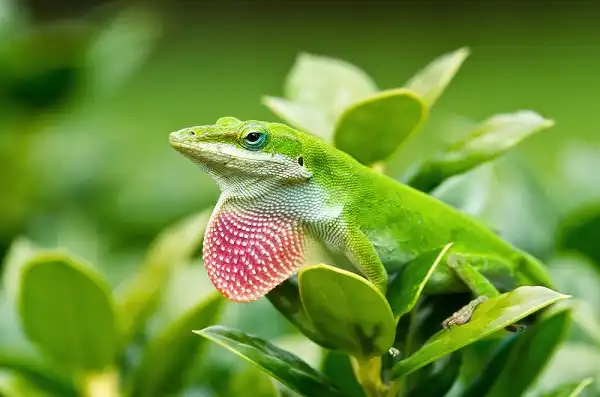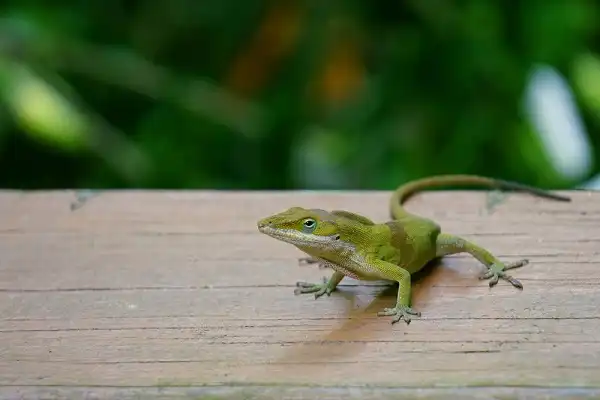Do you have a passion for exotic, cold-blooded creatures? If so, the Anole lizard may just be your perfect companion! Highly adaptive and able to survive across different climates, these lizards make for fascinating pets. Whether it’s exploring their bright colors or creating a natural environment in the home suitable to meet their needs, read on to find out more about Anole lizards and how they can make extraordinary pet companions.

Anole Lizard Description
Anole lizards are small to medium-sized reptiles. These lizards have slender bodies and long tails which make them well suited for climbing trees and other vegetation. Anoles are usually brown or olive green in color, though some species possess brilliant shades of red, yellow, orange, or blue. They also have two distinct “eyespots” located on either side of their necks. Anole lizards possess a number of adaptations that enable them to survive in different climates, including the ability to change colors and the presence of dewlap scales on their chins used for communication purposes.
In addition to their impressive physical characteristics, anole lizards can be quite intelligent and social creatures when given proper care and attention. When kept as pets, it’s important to provide anole lizards with a habitat that closely mimics natural conditions found in the wild. This includes providing branches and foliage for climbing as well as ultraviolet lighting for basking. Anoles feed mainly on insects such as crickets, but they may also enjoy occasional treats such as fruits or vegetables. Proper handling is essential when caring for these animals since they can stress easily and escape quickly if not monitored carefully.
Anole Lizard Habitat
Anole lizards require an appropriate habitat in order to remain healthy and thrive. Generally, the enclosure should be well-ventilated and provide enough space for the lizard to move about comfortably. Anoles prefer environments with plenty of foliage for climbing and hiding, so it is important to provide ample branches and plants as well as artificial vines or tunnels. A secure lid will also be necessary to prevent escape attempts. The enclosure should also be equipped with a heat source (such as a heat lamp) with temperatures ranging from 73-85°F (23-29°C). Additionally, an ultraviolet light source should be used during daytime hours to simulate natural sunlight for basking purposes.
The substrate is another important factor when setting up a habitat for anoles. Ideal substrates include coir, bark chips, or reptile carpeting designed specifically for lizards—avoid sand or gravel as these can cause impaction if ingested. Finally, misting systems are beneficial in providing your pet with the humidity levels they need to stay hydrated throughout the day. It’s also important to keep your pet’s enclosure clean by regularly removing uneaten food and droppings. With the right environment set up and regular maintenance, anole lizards can live happily in captivity!
Anole Lizard Diet
Anole lizards primarily eat insects such as crickets, mealworms, roaches, and other small bugs. They also occasionally enjoy treats like fruits and vegetables. To ensure a well-rounded diet, it is important to provide varied sources of food that are nutritionally adequate. As omnivores, anoles benefit from high-quality commercial diets that are supplemented with live prey. Feeding them 2 to 3 times a week should be sufficient in meeting their nutritional needs. In addition to providing nutrient-rich foods, the water source for your anole lizard should also be kept clean and free of bacteria or parasites. Bathing them in warm water at least two to three times per week is beneficial in keeping skin healthy and hydrated as well as helping with digestion and metabolism functions. It is also important to ensure that the humidity levels remain between 60-80% by misting the enclosure regularly or adding a humidifier if necessary.

Anole Lizard Size
Anole lizards generally range in size from 3.5 to 7.5 inches in length, with the average adult reaching around 6 inches. They have a slender body and long tail which makes them well suited for climbing trees and other vegetation. Females tend to be smaller than males, though some species can vary widely in size depending on their environment and diet. Anoles are typically brown or olive green in color, though some have vibrant colors such as red, yellow, orange, or blue.
Anole Lizard Lifespan
Anole lizards have an average lifespan of 10 years when kept as pets, though this can vary depending on the species and environment. In the wild, anole lizards live for around 4-5 years due to predation and other environmental factors. With proper care and attention, however, anoles can thrive in captivity for much longer. When cared for correctly, anoles tend to be active and lively creatures who are also quite intelligent. They require a habitat that closely mimics natural conditions found in the wild with plenty of foliage for climbing and basking areas with appropriate levels of ultraviolet lighting. It is also important to provide them with high-quality nutrition as well as regular baths to keep their skin hydrated and healthy. Overall, anoles make fascinating pet companions due to their active personalities and unique physical characteristics such as their ability to change colors depending on the environment or dewlap scales used for communication purposes.
Anole Lizard Behavior
Anole lizards are highly active and intelligent creatures that display a wide range of behaviors in the wild and in captivity. They are known to communicate with one another through various body language cues such as head bobbing, tail waving, and dewlap displays. Anoles also have the ability to change colors depending on the temperature and humidity levels around them, which helps them remain camouflaged from predators or alert other anoles to their presence. In terms of social behavior, anoles tend to be territorial when living in groups or with other reptiles. Generally speaking, they prefer having plenty of space for themselves and will often try to establish dominance over others by displaying aggressive behavior such as biting or chasing. It is important for owners to provide enough space and hiding places within their enclosure to allow multiple lizards to coexist peacefully. When it comes to activity levels, anoles can be quite active during the day and become more sedentary at night. They are known for being very curious creatures who love exploring their environment and taking advantage of any available foliage for climbing purposes.

Anole Lizard Speed
Anole lizards are known to be quick and agile creatures, capable of leaping from branch to branch with ease. They have an impressive top speed of up to 12 miles per hour, allowing them to escape predators or chase after prey quickly. Anoles can also move swiftly in short bursts, reaching speeds of up to 11 body lengths per second when running away from danger. This agility is likely due to their long tails and slender bodies which allow for an impressive range of motion. These lizards also possess a unique form of locomotion known as “steal running” which involves the use of their front legs and tail for increased speed and agility. This is especially useful in arboreal environments such as rainforests where branches may be too thin or distant for the lizard to leap across safely.
Anole Lizard Hunting
Anole lizards have evolved to become expert hunters in order to survive in the wild. They will use their keen eyesight and lightning speed to stalk their prey, often lurking in wait for an unsuspecting insect or small rodent. Anoles will then pounce on their prey with remarkable agility, using their powerful claws and teeth to subdue it before consuming it whole. In terms of hunting strategies, anoles usually employ ambush tactics by blending into the environment and waiting patiently until a potential meal passes by. They are also known to use scent trails left by food sources as well as visual cues such as movement or color change in order to track down prey.
Additionally, they have been observed using “sit-and-wait” tactics which involve simply sitting motionless while waiting for a potential meal—something which is aided by their ability to change colors depending on the temperature or humidity levels around them. When hunting creatures such as insects, anoles will typically try to corner them before attacking. This allows the lizard time to assess its surroundings and plan out its attack strategy accordingly.
Anole Lizard Reproduction and Life Cycle
Anole lizards are capable of reproducing both sexually and asexually. During sexual reproduction, male anoles court females by displaying their colorful dewlaps and performing various courtship behaviors such as head bobbing and tail waving. After mating, the female will lay her eggs in a warm, moist environment between rocks or leaves in order to protect them from predators and harsh weather conditions. Once hatched, baby anoles will go through several stages of growth known as instars before reaching adulthood. During each stage, the lizard will shed its skin in order to reveal a new layer—this allows them to grow bigger and stronger with each shedding. Depending on the species, it can take anywhere from 4-12 months for an anole to mature into adulthood.

Anole Lizard Predators
Anole lizards are small creatures and therefore vulnerable to attack from larger predators. The most common predators of anole lizards include snakes, birds, cats, dogs, and other larger reptiles. These animals will typically search for anoles in their natural environment in order to hunt them down and consume them as a source of food. In addition to large predators, anoles must also watch out for other smaller threats such as spiders, centipedes, wasps, and scorpions which may prey on these reptiles. Furthermore, some parasites such as mites can also pose a threat by wreaking havoc on the lizard’s immune system—this is why it is important that owners take special care when handling their pet anoles.
Conclusion
Anole lizards are incredible reptiles that possess a wide range of adaptive skills and behaviors for hunting and surviving in the wild. With their keen eyesight, lightning speed, and remarkable agility, anoles are capable hunters who employ various strategies to track down prey. Additionally, they have an impressive lifespan when given proper care and attention which makes them great companion creatures for those looking for a fascinating pet with plenty of energy! Anole lizards must remain vigilant in their environment due to the numerous threats they face from both large and small predators alike.
Frequently Asked Question


